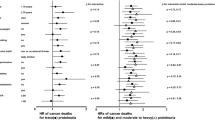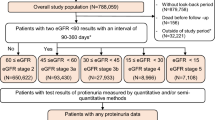Abstract
Background
The association between proteinuria and malignancy has been frequently reported, but the issue is matter of controversy. Thus, in order to shed light on the association, we evaluated proteinuria as a risk factor for malignancy using the dataset from the Korean National Health Insurance System (NHIS).
Methods
The subjects had undergone a medical examination in 2009 (index year) among the entire Korean adult population. From a pool of 10,505,818 participants, we excluded subjects who were younger than 19 years (15,327), had a previous diagnosis of cancer (152,095), had missing data for at least one variable (544,508), and were diagnosed with cancer within 1 year from the index year (79,501). Proteinuria was examined by a single dipstick urinalysis.
Results
A total of 9,714,387 subjects were included in this study and tracked until December 31, 2017. The participants were divided into three groups; no (95.2%), trace (2.3%), and overt (2.5%) proteinuria. Over the duration of this study, we observed that overt proteinuria was associated with an increased risk of cancer development (all cancers) (adjusted HR 1.154, 95% CI 1.134–1.173) and the long-term risk of cancer incidence increased proportionally according to the changes in proteinuria over a four-year period.
Limitations
Our study population consisted of Korean adults. Therefore, the results of this study may not be generalized to other ethnicities.
Conclusions
We found a significant relationship between proteinuria and the risk of overall and site-specific cancer development. Further studies are needed to find an explanation of these findings.



Similar content being viewed by others
References
Cravedi P, Ruggenenti P, Remuzzi G (2012) Proteinuria should be used as a surrogate in CKD. Nat Rev Nephrol 8(5):301–306
Cravedi P, Remuzzi G (2013) Pathophysiology of proteinuria and its value as an outcome measure in chronic kidney disease. Br J Clin Pharmacol 76(4):516–523
Powe NR, Boulware LE (2009) Population-based screening for CKD. Am J Kidney Dis 53(3 Suppl 3):S64–S70
Hillege HL et al (2002) Urinary albumin excretion predicts cardiovascular and noncardiovascular mortality in general population. Circulation 106(14):1777–1782
Romundstad S et al (2003) Microalbuminuria and all-cause mortality in 2,089 apparently healthy individuals: a 4.4-year follow-up study The Nord-Trondelag Health Study (HUNT), Norway. Am J Kidney Dis 42(3):466–473
Minutolo R et al (2018) Cardiorenal prognosis by residual proteinuria level in diabetic chronic kidney disease: pooled analysis of four cohort studies. Nephrol Dial Transpl 33(11):1942–1949
Mule G et al (2017) Subclinical kidney damage in hypertensive patients: a renal window opened on the cardiovascular system. Focus on microalbuminuria. Adv Exp Med Biol 956:279–306
Kwon Y et al (2018) Dipstick proteinuria predicts all-cause mortality in general population: a study of 17 million Korean adults. PLoS One 13(6):e0199913
Jorgensen L et al (2008) Association of albuminuria and cancer incidence. J Am Soc Nephrol 19(5):992–998
Lin YS et al (2010) Association of albuminuria and cancer mortality. Cancer Epidemiol Biomark Prev 19(11):2950–2957
Mok Y et al (2017) Kidney function, proteinuria, and cancer incidence: the Korean Heart study. Am J Kidney Dis 70(4):512–521
Mihai S et al (2018) Inflammation-related mechanisms in chronic kidney disease prediction, progression, and outcome. J Immunol Res 2018:2180373
Cobo G, Lindholm B, Stenvinkel P (2018) Chronic inflammation in end-stage renal disease and dialysis. Nephrol Dial Transpl 33(supp_3):iii35–iii40
Elinav E et al (2013) Inflammation-induced cancer: crosstalk between tumours, immune cells and microorganisms. Nat Rev Cancer 13(11):759–771
Coussens LM, Werb Z (2002) Inflammation and cancer. Nature 420(6917):860–867
Bacchetta J et al (2009) Paraneoplastic glomerular diseases and malignancies. Crit Rev Oncol Hematol 70(1):39–58
Pani A et al (2016) Glomerular diseases and cancer: evaluation of underlying malignancy. J Nephrol 29(2):143–152
Wong G et al (2009) Association of CKD and cancer risk in older people. J Am Soc Nephrol 20(6):1341–1350
Christensson A et al (2013) Association of cancer with moderately impaired renal function at baseline in a large, representative, population-based cohort followed for up to 30 years. Int J Cancer 133(6):1452–1458
Wong G et al (2012) The risk of cancer in people with diabetes and chronic kidney disease. Nephrol Dial Transplant 27(8):3337–3344
Lowrance WT et al (2014) CKD and the risk of incident cancer. J Am Soc Nephrol 25(10):2327–2334
Lee YH et al (2016) Data analytic process of a nationwide population-based study using national health information database established by national health insurance service. Diabetes Metab J 40(1):79–82
Seong SC et al (2017) Cohort profile: the National Health Insurance Service-National Health Screening Cohort (NHIS-HEALS) in Korea. BMJ Open 7(9):e016640
Levey AS et al (2006) Using standardized serum creatinine values in the modification of diet in renal disease study equation for estimating glomerular filtration rate. Ann Intern Med 145(4):247–254
Oh SW et al (2004) Cut-off point of BMI and obesity-related comorbidities and mortality in middle-aged Koreans. Obes Res 12(12):2031–2040
Jhaveri KD et al (2013) Glomerular diseases seen with cancer and chemotherapy: a narrative review. Kidney Int 84(1):34–44
Cambier JF, Ronco P (2012) Onco-nephrology: glomerular diseases with cancer. Clin J Am Soc Nephrol 7(10):1701–1712
Alpers CE, Cotran RS (1986) Neoplasia and glomerular injury. Kidney Int 30(4):465–473
Vaziri ND (2012) CKD impairs barrier function and alters microbial flora of the intestine: a major link to inflammation and uremic toxicity. Curr Opin Nephrol Hypertens 21(6):587–592
Kurts C et al (2013) The immune system and kidney disease: basic concepts and clinical implications. Nat Rev Immunol 13(10):738–753
James MT et al (2008) Risk of bloodstream infection in patients with chronic kidney disease not treated with dialysis. Arch Intern Med 168(21):2333–2339
Daya N et al (2016) Kidney function and fracture risk: the atherosclerosis risk in communities (ARIC) study. Am J Kidney Dis 67(2):218–226
Matas AJ et al (1975) Increased incidence of malignancy during chronic renal failure. Lancet 1(7912):883–886
Peces R (2003) Malignancy and chronic renal failure. Saudi J Kidney Dis Transpl 14(1):5–14
Jager A et al (2002) C-reactive protein and soluble vascular cell adhesion molecule-1 are associated with elevated urinary albumin excretion but do not explain its link with cardiovascular risk. Arterioscler Thromb Vasc Biol 22(4):593–598
Stehouwer CD et al (2002) Increased urinary albumin excretion, endothelial dysfunction, and chronic low-grade inflammation in type 2 diabetes: progressive, interrelated, and independently associated with risk of death. Diabetes 51(4):1157–1165
Paisley KE et al (2003) Endothelial dysfunction and inflammation in asymptomatic proteinuria. Kidney Int 63(2):624–633
Franses JW et al (2013) Dysfunctional endothelial cells directly stimulate cancer inflammation and metastasis. Int J Cancer 133(6):1334–1344
Largo R et al (1999) Angiotensin-converting enzyme is upregulated in the proximal tubules of rats with intense proteinuria. Hypertension 33(2):732–739
Ager EI, Neo J, Christophi C (2008) The renin-angiotensin system and malignancy. Carcinogenesis 29(9):1675–1684
Barton CH, Vaziri ND, Spear GS (1980) Nephrotic syndrome associated with adenocarcinoma of the breast. Am J Med 68(2):308–312
Samal L, Linder JA (2013) The primary care perspective on routine urine dipstick screening to identify patients with albuminuria. Clin J Am Soc Nephrol 8(1):131–135
Mishima E, Haruna Y, Arima H (2019) Renin-angiotensin system inhibitors in hypertensive adults with non-diabetic CKD with or without proteinuria: a systematic review and meta-analysis of randomized trials. Hypertens Res 42(4):469–482
Pinter M, Jain RK (2017) Targeting the renin-angiotensin system to improve cancer treatment: implications for immunotherapy. Sci Transl Med 9(410):eaan5616
Funding
The authors received no specific funding for this work.
Author information
Authors and Affiliations
Contributions
SYA and YJC contributed equally to this work. SYA and YGP have full access to all of the data in the study and take responsibility for the integrity of the data and the accuracy of the data analysis. YJC, KH, and GJK participated in research design. KH, GJK, and YJK participated in analysis and interpretation of data. YJC and KH participated in data collection.
Corresponding authors
Ethics declarations
Conflict of interest
The authors have declared no conflicts of interest.
Ethical statement
All procedures performed in studies involving human participants were in accordance with the ethical standards of the institutional and/or national research committee and with the 1964 Helsinki declaration and its later amendments or comparable ethical standards. Ethical approval was waived in this study by the Institutional Review Board (IRB) of Korea University Medical Center Guro Hospital (Seoul, Korea) (#IRB No. K2019-0642-001). Informed consent was not obtained because patient records and information were anonymized and de-identified prior to analysis. This study was also approved by National Health Insurance Service (NHIS-2019-1-413).
Additional information
Publisher's Note
Springer Nature remains neutral with regard to jurisdictional claims in published maps and institutional affiliations.
Electronic supplementary material
Below is the link to the electronic supplementary material.
Rights and permissions
About this article
Cite this article
Ahn, S.Y., Choi, Y.J., Han, K. et al. Dipstick proteinuria and cancer incidence: a nationwide population-based study. J Nephrol 33, 1067–1077 (2020). https://doi.org/10.1007/s40620-020-00740-1
Received:
Accepted:
Published:
Issue Date:
DOI: https://doi.org/10.1007/s40620-020-00740-1




